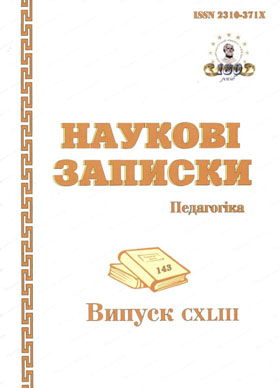EDUCATIONAL AND TRANSLATORS ACTIVITIES OF WILHELM KIESEWETTER ON THE RESULTS OF THE EXPEDITION IN THE CRIMEA
DOI:
https://doi.org/10.31392/NZ-npu-143.2019.30Ключові слова:
creativity, translator, artist, ethnographer, Wilhelm Kiesewetter, travels in Crimea, communication, travelАнотація
Many European scientists and artists of the XVIII–XIX centuries travel to many distant countries. They dreamed of exploring the world, in order to subsequently transfer their knowledge and discoveries to society in the form of reports, paintings, texts, books and sculptures.
With the help of their paintings, they wanted to convey the experience of communication and communication with other distant peoples. This didactic aspect was generally characteristic of genre art, which in the XIX century, gained popularity from the European public. At the same time, subject paintings based on the personal experience of the traveler and the artist were considered. One of these artists was the Berlin artist-ethnographer Wilhelm Kiesewetter. He made two different journeys and for fourteen years traveled in Scandinavia, the European part of Russia, the Crimea and the Caucasus. He traveled on foot, riding and riding in a carriage, traveling with the help of camels and ships. It was financed by making portraits that sold well in Sweden.
The work presents his paintings depicting the life and life of people living in the Crimea.
In his expeditions, Kiesewetter drew different peoples”, in order to later lay the foundation of the museum of man. He really wanted and hoped that his travel results and the material brought in the form of public exhibitions would be of great public interest. Kiesewetter noted: “what could be more interesting than observing the diversity of different peoples living in this world at the same time with us”.Посилання
“Eugène Delacroix biography”. Web Gallery of Art. Retrieved 2007-06-14. André Castelot (Talleyrand ou le cynisme [Paris, Librairie Perrin, 1980])
Eugène Delacroix, Journal, nouvelle édition intégrale établie par Michèle Hannoosh, 2 vols., Paris, José Corti, 2009.
Pablo Diener-Ojeda: Johann Moritz Rugendas. Bilder aus Mexiko. Bildband und Katalog zur Ausstellung Augsburg, 1993. Wissner, Augsburg, 1993,
Gertrud Richert: Johann Moritz Rugendas. Ein deutscher Maler des XIX. Jahrhunderts. Berlin, 1959.
Christof Metzger/Christof Trepesch: Ch ile und Johann Moritz Rugendas. Wernersche Verlagsgesellschaft, 2007.
Pablo Diener-Ojeda: El viaje de Rugendas por Chile 1834–1842. Origo Ediciones. Santiago, 2012.
John Catlin. Illustrations of the manners, customs & condition of the North American Indians. – London : Chatto & Windus, 1876. – Vol. 1.
John Catlin. Life Among the Indians. – London : Gall and Inglis, 1861. – Vol. 2.
Tietmeyer E. The Painter Wilhelm Kiesewetter in the Crimea (1845–1947), Islamic Art and Architecture in the European Periphery : Crimea, Caucasus and Volga-Ural Region, Ed. Barbara Kellner-Heinkele, Joachim Gierlichs, Brigitte Heuer, Wiesbaden : Harrassowitz, 2008, s. 109-117.
Bildung und Wissenschaft. 1999. № 4. s. 13-16


